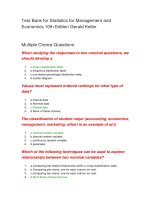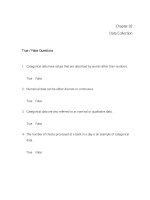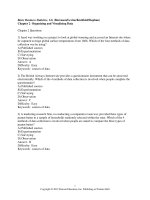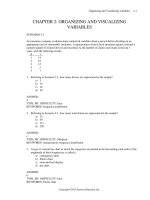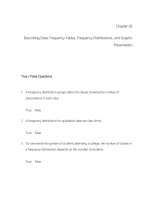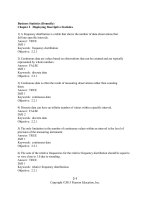Statistics salkind 4e test bank ch04
Bạn đang xem bản rút gọn của tài liệu. Xem và tải ngay bản đầy đủ của tài liệu tại đây (282.08 KB, 15 trang )
Chapter 4: A Picture Really Is Worth a Thousand Words
Test Bank
MULTIPLE CHOICE
1. Which of the following are among the things to remember when creating figures?
a. Use a lot of text
b. All graphs communicate several ideas
c. Do not label anything
d. Maintain the scale in the graph
ANS: D
PTS: 1
DIF: Easy
REF: Ten Ways to a Great Figure (Eat Less and Exercise More?)
OBJ: Using Excel to create charts
COG: Knowledge
2. What is the most basic method of illustrating data?
a. Frequency distribution
b. Pie chart
c. Line graph
d. Polygon
ANS: A
PTS: 1
DIF: Easy
REF: First Things First: Creating a Frequency Distribution
OBJ: Creating a histogram and a polygon
COG: Knowledge
3. When tallying and representing how often certain scores occur, which type of data illustration
method is being utilized?
a. Class interval
b. Frequency distribution
c. Histogram
d. Polygon
ANS: B
PTS: 1
DIF: Easy
REF: First Things First: Creating a Frequency Distribution
OBJ: Creating a histogram and a polygon
COG: Knowledge
4. Which of the following is an example of a table?
a. Frequency distribution
b. Frequency polygon
c. Histogram
d. Line chart
ANS: A
PTS: 1
DIF: Easy
REF: First Things First: Creating a Frequency Distribution
OBJ: Creating a histogram and a polygon
COG: Knowledge
5. Which of the following is NOT an example of a chart or graph?
a. Cumulative frequency distribution
b. Frequency polygon
c. Variation
d. Ogive
ANS: C
PTS: 1
DIF: Medium
REF: The Next Step: A Frequency Polygon
OBJ: Creating a histogram and a polygon
COG: Comprehension
6. Which of the following is NOT an example of a chart or graph?
a. Frequency polygon
b. Histogram
c. Column chart
d. Class interval
ANS: D
PTS: 1
DIF: Medium
REF: The Next Step: A Frequency Polygon
OBJ: Creating a histogram and a polygon
COG: Comprehension
7. A good rule of thumb when creating an illustration is
a. To make sure your graph communicates only one idea
b. Do not label items
c. Use a lot of text
d. Do not worry about centering titles and axis labels
ANS: A
PTS: 1
DIF: Easy
REF: Ten Ways to a Great Figure (Eat Less and Exercise More?)
OBJ: Using Excel to create charts
COG: Knowledge
8. Which of the following can be used to measure the shape of a distribution?
a. Mean
b. Mode
c. Kurtosis
d. Median
ANS: C
PTS: 1
DIF: Medium
OBJ: Using the SKEW and KURT functions
REF: Kurtosis
COG: Knowledge
9. Kurtosis is used to
a. Measure the central tendency of the distribution
b. Describe the shape of the distribution
c. Measure the variance in the distribution
d. Describe the range of a distribution
ANS: B
PTS: 1
DIF: Medium
OBJ: Using the SKEW and KURT functions
REF: Kurtosis
COG: Knowledge
10. What do you need to calculate first before calculating skewness?
a. Mean and median
b. Median and mode
c. Mode and mean
d. Mode and variance
ANS: A
PTS: 1
DIF: Medium
OBJ: Using the SKEW and KURT functions
REF: Kurtosis
COG: Knowledge
11. What you need to calculate first before calculating the kurtosis?
a. Mean and standard deviation
b. Median and standard deviation
c. Mode and variance
d. Median and variance
ANS: A
PTS: 1
DIF: Medium
OBJ: Using the SKEW and KURT functions
REF: Kurtosis
COG: Knowledge
12. A distribution of scores in which almost the entire class scored very high but a few students
scored fairly low would be _______.
a. Negatively skewed
b. Positively skewed
c. Unskewed
d. Normally distributed
ANS: A
PTS: 1
DIF: Medium
OBJ: Using the SKEW and KURT functions
REF: Skewness
COG: Application
13. A distribution of scores in which almost the entire class scored very low but a few students
scored fairly high would be _______.
a. Positively skewed
b. Negatively skewed
c. Unskewed
d. Normally distributed
ANS: A
PTS: 1
DIF: Medium
OBJ: Using the SKEW and KURT functions
REF: Skewness
COG: Application
14. What is the term associated with the upper or lower boundary of a set of scores used in the
creation of a frequency distribution?
a. Histogram
b. Polygon
c. Class interval
d. Frequency distribution
ANS: C
PTS: 1
DIF: Easy
REF: First Things First: Creating a Frequency Distribution
OBJ: Creating a histogram and a polygon
COG: Knowledge
15. If you have a distribution of 50 scores, and you want 10 intervals, what should be the size of
your class interval?
a. 50
b. 25
c. 10
d. 5
ANS: D
PTS: 1
DIF: Easy
OBJ: Creating a histogram and a polygon
REF: The Classiest of Intervals
COG: Application
16. If you have a distribution of 100 scores, and you want 20 intervals, what should be the size of
your class interval?
a. 50
b. 25
c. 10
d. 5
ANS: D
PTS: 1
DIF: Easy
OBJ: Creating a histogram and a polygon
REF: The Classiest of Intervals
COG: Application
17. If you have a distribution of 20 scores, and you want 2 intervals, what should be the size of
your class interval?
a. 50
b. 25
c. 10
d. 5
ANS: C
PTS: 1
DIF: Easy
OBJ: Creating a histogram and a polygon
REF: The Classiest of Intervals
COG: Application
18. If you have a distribution of 50 scores, and you want 5 intervals, what should be the size of
your class interval?
a. 50
b. 25
c. 10
d. 5
ANS: C
PTS: 1
DIF: Easy
OBJ: Creating a histogram and a polygon
REF: The Classiest of Intervals
COG: Application
19. Optimally, when choosing a class interval, you should have approximately this many intervals
covering the entire range of data:
a. 5 to 10
b. 1 to 10
c. 10 to 20
d. 20 to 50
ANS: C
PTS: 1
DIF: Easy
OBJ: Creating a histogram and a polygon
REF: The Classiest of Intervals
COG: Knowledge
20. Which of the following is the best range of number of data points for a class interval?
a. 40
b. 80
c. 20
d. 8
ANS: C
PTS: 1
DIF: Easy
OBJ: Creating a histogram and a polygon
REF: The Classiest of Intervals
COG: Application
21. The largest class interval goes here on a frequency distribution:
a. The top
b. The bottom
c. In the middle
d. Either at the top or bottom
ANS: A
PTS: 1
DIF: Easy
REF: First Things First: Creating a Frequency Distribution
OBJ: Creating a histogram and a polygon
COG: Comprehension
22. What type of chart or graph displays class intervals along an x-axis?
a. Pie chart
b. Line graph
c. Histogram
d. Tally marks
ANS: C
PTS: 1
DIF: Easy
REF: The Plot Thickens: Creating a Histogram
OBJ: Creating a histogram and a polygon
COG: Knowledge
23. What is a method of tallying and representing how often certain scores occur?
a. Histogram
b. Midpoint
c. Frequency distribution
d. Bar chart
ANS: C
PTS: 1
DIF: Easy
REF: First Things First: Creating a Frequency Distribution
OBJ: Creating a histogram and a polygon
COG: Comprehension
24. What is a graphical representation of a frequency distribution?
a. Bar chart
b. Frequency distribution
c. Histogram
d. Cumulative frequency distribution
ANS: C
PTS: 1
DIF: Easy
REF: The Plot Thickens: Creating a Histogram
OBJ: Creating a histogram and a polygon
COG: Knowledge
25. What is the central point of the class interval called?
a. Median
b. Mode
c. Histogram
d. Midpoint
ANS: D
PTS: 1
DIF: Easy
REF: The Plot Thickens: Creating a Histogram
OBJ: Creating a histogram and a polygon
COG: Knowledge
26. This is a type of chart in which categories are organized horizontally on the x-axis, and values
are shown vertically on the y-axis.
a. Bar chart
b. Histogram
c. Line chart
d. Column chart
ANS: D
PTS: 1
OBJ: Using Excel to create charts
DIF: Easy
REF: Excel-lent Charts
COG: Comprehension
27. Which of the following do NOT have to be filled to create a histogram in Excel?
a.
b.
c.
d.
Input range
Output range
Medium range
Bin range
ANS: C
PTS: 1
DIF: Medium
REF: Using the Amazing Data Analysis Tools to Create a Histogram
OBJ: Using Excel to create charts
COG: Comprehension
28. A chart that contains a continuous line that represents the frequencies of scores within a class
interval is also known as a _______.
a. Standard deviation
b. Histogram
c. Frequency polygon
d. Frequency distribution
ANS: C
PTS: 1
DIF: Medium
REF: The Next Step: A Frequency Polygon
OBJ: Different types of charts and their uses
COG: Knowledge
29. What is the frequency distribution that shows frequencies for class intervals, along with the
cumulative frequency for each?
a. Frequency distribution
b. Frequency polygon
c. Cumulative frequency distribution
d. Midpoint
ANS: C
PTS: 1
DIF: Medium
OBJ: Different types of charts and their uses
REF: Cumulating Frequencies
COG: Knowledge
30. This is another word for the lopsidedness of a distribution:
a. Kurtosis
b. Skewness
c. Platykurtic
d. Leptokurtic
ANS: B
PTS: 1
DIF: Easy
OBJ: Using the SKEW and KURT functions
REF: Skewness
COG: Knowledge
31. If you wanted to look at the flatness or peak of a distribution, you would need to look at
_______.
a. Kurtosis
b. Skewness
c. Standard deviation
d. Standard error
ANS: A
PTS: 1
DIF: Medium
OBJ: Using the SKEW and KURT functions
32. What is another name for a cumulative frequency polygon?
a. Ogive
b. Cumulative polygon
c. Olive
REF: Kurtosis
COG: Application
d. Cumulative tally
ANS: A
PTS: 1
DIF: Medium
OBJ: Different types of charts and their uses
REF: Cumulating Frequencies
COG: Knowledge
33. What is the term associated with the lack of symmetry in a distribution?
a. Ogive
b. Skewness
c. Kurtosis
d. Variability
ANS: B
PTS: 1
DIF: Medium
OBJ: Using the SKEW and KURT functions
REF: Skewness
COG: Knowledge
34. In order to say that a distribution is positively skewed, which of the following must be true?
a. Right tail must be longer than left
b. Right tail must be shorter than left
c. Right and left tail must be equal
d. Curve must be bell shaped
ANS: A
PTS: 1
DIF: Medium
OBJ: Using the SKEW and KURT functions
REF: Skewness
COG: Knowledge
35. In order to say that a distribution is negatively skewed, which of the following must be true?
a. Right tail must be longer than the left
b. Left tail must be longer than the right
c. Both tails must be of equal length
d. The curve must be bell shaped
ANS: B
PTS: 1
DIF: Medium
OBJ: Using the SKEW and KURT functions
REF: Skewness
COG: Knowledge
36. When the left tail of a distribution’s curve is longer the right, what is this called?
a. Platykurtic
b. Leptokurtic
c. Positive skew
d. Negative skew
ANS: D
PTS: 1
DIF: Medium
OBJ: Using the SKEW and KURT functions
REF: Skewness
COG: Knowledge
37. When most people scored high on a test of knitting knowledge, and very few people scored
low, what is the distribution called?
a. Platykurtic
b. Leptokurtic
c. Positively skewed
d. Negatively skewed
ANS: C
PTS: 1
DIF: Medium
OBJ: Using the SKEW and KURT functions
REF: Skewness
COG: Application
38. What is the term associated with how flat or peaked a distribution appears?
a. Ogive
b. Skewness
c. Kurtosis
d. Variability
ANS: C
PTS: 1
DIF: Easy
OBJ: Using the SKEW and KURT functions
REF: Kurtosis
COG: Knowledge
39. Which of the following refers to a distribution’s curve that is relatively peaked in comparison
to a normal curve?
a. Platykurtic
b. Leptokurtic
c. Positive skew
d. Negative skew
ANS: B
PTS: 1
DIF: Medium
OBJ: Using the SKEW and KURT functions
REF: Kurtosis
COG: Knowledge
40. Which of the following refers to distribution’s curve that is relatively flat in comparison to a
normal curve?
a. Platykurtic
b. Leptokurtic
c. Positive skew
d. Negative skew
ANS: A
PTS: 1
DIF: Medium
OBJ: Using the SKEW and KURT functions
REF: Kurtosis
COG: Knowledge
41. If the mean of a set of scores is greater than the median, what can be said about the
distribution?
a. Negatively skewed
b. Positively skewed
c. Leptokurtic
d. Platykurtic
ANS: B
PTS: 1
DIF: Medium
OBJ: Using the SKEW and KURT functions
REF: Skewness
COG: Knowledge
42. If the median of a set of scores is greater than the mean, what can be said about the
distribution?
a. Negatively skewed
b. Positively skewed
c. Platykurtic
d. Leptokurtic
ANS: A
PTS: 1
DIF: Medium
OBJ: Using the SKEW and KURT functions
REF: Skewness
COG: Knowledge
43. If you wanted to examine the proportion of students in this class who are male compared to
female, which of the following might you use?
a. Ogive
b. Line graph
c. Pie chart
d. Frequency polygon
ANS: C
PTS: 1
DIF: Medium
OBJ: Different types of charts and their uses
REF: Pie Charts
COG: Application
44. If you were interested in tracking your GPA during the time you are in graduate school, which
of the following might you use?
a. Bar chart
b. Line graph
c. Pie chart
d. Histogram
ANS: B
PTS: 1
DIF: Medium
OBJ: Different types of charts and their uses
REF: Line Charts
COG: Application
45. Which of the following does a histogram most look like?
a. Pie chart
b. Bar graph
c. Frequency polygon
d. Ogive
ANS: B
PTS: 1
DIF: Medium
REF: Excel-lent Charts Part Deux: Making Charts Pretty
OBJ: Different types of charts and their uses
COG: Comprehension
46. If you wanted to depict trends in ice cream sales over the four seasons, what kind of chart
would you use?
a. Histogram
b. Line chart
c. Pie chart
d. Bar chart
ANS: B
PTS: 1
DIF: Medium
OBJ: Different types of charts and their uses
REF: Line Charts
COG: Application
47. What is the horizontal axis on a graph called?
a. x-axis
b. y-axis
c. z-axis
d. Frequency axis
ANS: A
PTS: 1
DIF: Easy
REF: The Plot Thickens: Creating a Histogram
OBJ: Using the Data Analysis tools to create a histogram
48. What is the vertical axis on a graph called?
a. x-axis
b. y-axis
c. z-axis
d. Nominal axis
ANS: B
PTS: 1
DIF: Easy
REF: The Plot Thickens: Creating a Histogram
COG: Comprehension
OBJ: Using the Data Analysis tools to create a histogram
COG: Comprehension
49. If the mean = 24, and the median = 24, then what can be said of the distribution?
a. Positively skewed
b. Negatively skewed
c. No skew
d. Leptokurtic
ANS: C
PTS: 1
DIF: Medium
OBJ: Using the SKEW and KURT functions
REF: Skewness
COG: Application
50. To modify a chart’s elements in Excel, which of the following icons should you click on?
a. Brush icon
b. Plus sign icon
c. Heart shape icon
d. Minus sign icon
ANS: B
PTS: 1
REF: Working With Chart Elements
COG: Knowledge
DIF: Easy
OBJ: Using Excel to modify charts
51. If the mean = 34, and the median = 25, then what can be said of the distribution?
a. Positively skewed
b. Negatively skewed
c. Inversely skewed
d. Symmetrical
ANS: A
PTS: 1
DIF: Medium
OBJ: Using the SKEW and KURT functions
REF: Skewness
COG: Application
52. If the mean = 12, and the median = 21, then what can be said of the distribution?
a. Positively skewed
b. Negatively skewed
c. Inversely skewed
d. Symmetrical
ANS: B
PTS: 1
DIF: Medium
OBJ: Using the SKEW and KURT functions
REF: Skewness
COG: Application
TRUE/FALSE
1. A histogram conveys the same information that a frequency polygon does.
ANS: T
PTS: 1
DIF: Easy
REF: The Next Step: A Frequency Polygon
OBJ: Different types of charts and their uses
COG: Knowledge
2. Two sets of scores with different measures of central tendency and variability will result in
two different-looking distributions.
ANS: T
PTS: 1
DIF: Medium
REF: Fat and Skinny Frequency Distributions
OBJ: Using the SKEW and KURT functions
COG: Comprehension
3. A visual representation of data can be a much more effective way of illustrating the
characteristics of a distribution or data set as compared to numerical values alone.
ANS: T
PTS: 1
DIF: Easy
OBJ: Why a picture really is worth a thousand words
REF: Why Illustrate Data?
COG: Comprehension
4. More is more; the more functions, features, and so forth you can include on a graph, the
better.
ANS: F
PTS: 1
DIF: Easy
REF: Ten Ways to a Great Figure (Eat Less and Exercise More?)
OBJ: Using Excel to create charts
COG: Comprehension
SHORT ANSWER
1. Why are measures of central tendency and measures of variability important to a visual
representation of the distribution of data?
ANS:
Measures of central tendency indicate the one best score for describing a group of data,
whereas measures of variability indicate how diverse, or different, scores are from one
another. Together, these two measures can result in distributions that look different.
PTS: 1
DIF: Medium
REF: Why Illustrate Data?
OBJ: Why a picture really is worth a thousand words
COG: Analysis
2. What are some ways to make a good chart?
ANS:
Minimize chart junk, plan out your chart before making the final copy, say only what you
mean to say, label everything, communicate only one idea, keep things balanced, maintain the
scale, keep it simple, and limit the number of words.
PTS: 1
DIF: Medium
REF: Ten Ways to a Great Figure (Eat Less and Exercise More?)
OBJ: Using Excel to create charts
COG: Comprehension
3. What is a frequency distribution?
ANS:
The most basic way to illustrate data is through the creation of a frequency distribution, which
tallies (counts) how often certain scores occur, usually in class intervals.
PTS: 1
DIF: Medium
REF: First Things First: Creating a Frequency Distribution
OBJ: Different types of charts and their uses
4. Describe the process of creating a class interval.
COG: Comprehension
ANS:
To create a class interval, first select a class interval that has a desired number of data points
(e.g., 2, 5, 10, or 20). Next, select how many class intervals you want, so that the entire range
of data is covered (e.g., 10, 20, or 50). Then, begin listing the class interval with a multiple of
that interval. Finally, list the intervals, placing the largest interval at the top of the frequency
distribution.
PTS: 1
DIF: Medium
REF: The Classiest of Intervals
OBJ: Creating a histogram and a polygon
COG: Comprehension
5. What is a histogram?
ANS:
A histogram is a visual representation of the frequency distribution where the frequencies are
represented by bars.
PTS: 1
DIF: Medium
REF: The Plot Thickens: Creating a Histogram
OBJ: Creating a histogram and a polygon
COG: Comprehension
6. What is a frequency polygon?
ANS:
A frequency polygon is a continuous line that represents the frequencies of scores within a
class interval.
PTS: 1
DIF: Medium
REF: The Next Step: A Frequency Polygon
OBJ: Creating a histogram and a polygon
COG: Comprehension
7. Besides histograms and polygons, describe four types of charts commonly used in behavioral
and social sciences to illustrate data.
ANS:
Four types of charts commonly used in behavioral and social science fields to illustrate data
include column charts, bar charts, line charts, and pie charts. Column charts are used to show
how data change over a period of time or when comparing different categories with one
another. Bar charts depict the identical information as column charts, but the axes are
switched. Line charts are used to show a trend in the data at equal intervals. Finally, pie charts
are used to show proportions of an item that makes up a series of data points.
PTS: 1
DIF: Medium
REF: Other Cool Charts
OBJ: Different types of charts and their uses
COG: Comprehension
8. What are the four different ways that distributions can be different from one another?
ANS:
They can differ in their average value, their variability, their skewness, and their kurtosis.
PTS: 1
DIF: Medium
REF: Fat and Skinny Frequency Distributions
OBJ: Different types of charts and their uses
COG: Comprehension
9. Define skewness.
ANS:
Skewness is a measure of the lack of symmetry in a distribution.
PTS: 1
DIF: Medium
REF: Skewness
OBJ: Using the SKEW and KURT functions
COG: Knowledge
10. For a normal bell-shaped curve, what is the kurtosis?
ANS:
The normal bell-shaped curve serves as the reference point for determining kurtosis. Because
the distribution in question does not differ from the reference distribution, we write that there
is no kurtosis.
PTS: 1
DIF: Medium
REF: Kurtosis
OBJ: Using the SKEW and KURT functions
COG: Analysis
11. Define positive skew and negative skew.
ANS:
Positive skew refers to a distribution where the mean is greater than the median. Distributions
with positive skew have a long right tail. Negative skew refers to a distribution where the
median is greater than the mean. Distributions with negative skew have a long left tail.
PTS: 1
DIF: Medium
REF: Skewness
OBJ: Using the SKEW and KURT functions
COG: Comprehension
12. Describe what a leptokurtic distribution looks like and what a platykurtic distribution looks
like.
ANS:
A leptokurtic distribution is relatively peaked compared to a normal, bell-shaped curve. In
these distributions, a high frequency of scores is very close to the mean. A platykurtic
distribution is relatively flat compared to a normal distribution, reflecting a more equal
distribution of scores across the range of scores.
PTS: 1
DIF: Medium
REF: Kurtosis
OBJ: Using the SKEW and KURT functions
COG: Comprehension
13. Apply the information you have already learned about measures of central tendency—such as
the mean, median, and mode—and measures of variability—such as the range, standard
deviation, and variance—to the four ways distributions can differ (i.e., average value,
variability, skewness, and kurtosis). Imagine you are reviewing the midterm exam grades of
students in three different sections of a “Counseling Theories” class. Draw yourself pictures
of the distributions if that will help you think through the answers. You have a figure of the
distributions of the most recent exam from those three groups of students. As you examine the
figure, you realize that the distributions do not overlap very much. Please label which of the
four ways that distributions can differ that is demonstrated by this figure. Then, describe what
the figure illustrates is different about the mean scores of the midterm exam from the students
in the three different sections of the “Counseling Theories” class.
ANS:
The average value or score of the exam grades of the three sections of the class are different.
This means that the average score for one class section was low, the average score for the
second section of the class was in the middle, and the average score of the third section of the
class was much better—it was high.
PTS: 1
DIF: Hard
REF: Fat and Skinny Frequency Distributions
OBJ: Why a picture really is worth a thousand words
COG: Analysis
14. Apply the information you have already learned about measures of central tendency—such as
the mean, median, and mode—and measures of variability—such as the range, standard
deviation, and variance—to the four ways distributions can differ (i.e., average value,
variability, skewness, and kurtosis). Imagine you are reviewing the midterm exam grades of
students in three different sections of a “Counseling Theories” class. Draw yourself pictures
of the distributions if that will help you think through the answers. You have a figure of the
distributions of the final exam from the three sections of the “Counseling Theories” class.
While the mean scores among the sections appear to be similar, the distribution of the scores
for Section One has a relatively tall peak; the distribution of the scores for Section Two looks
normal; and the distribution of scores for Section Three is slightly flat. Please label the way
that these three distributions differ, and then, describe what might be happening with the
means and standard deviations of each section of “Counseling Theories” class.
ANS:
These exam scores differ in variability. All the mean scores are the same, but their variability
(likely expressed in standard deviation values) is different. One section has a small standard
deviation, showing more of a peak to the distribution. One section has an in-between standard
deviation, showing nothing remarkable. The final section shows the largest amount of
variability, demonstrated by a flatter distribution and a larger standard deviation.
PTS: 1
DIF: Hard
REF: Fat and Skinny Frequency Distributions
OBJ: Why a picture really is worth a thousand words
COG: Analysis
15. Apply the information you have already learned about measures of central tendency—such as
the mean, median, and mode—and measures of variability—such as the range, standard
deviation, and variance—to the four ways distributions can differ (i.e., average value,
variability, skewness, and kurtosis). Imagine you are reviewing the midterm exam grades of
students in three different sections of a “Counseling Theories” class. Draw yourself pictures
of the distributions if that will help you think through the answers. The “Counseling Theories”
class had a pop quiz last week, and their quiz scores just came back. While the Section One
students were taking the quiz, you had to leave the room for an urgent university matter. You
had your suspicions that the class may have cheated. Now that the quiz results are back, you
are even more suspicious because the standard deviation of the Section One scores is very
small, showing that there is not much variability (dispersion of the scores from the mean).
Please label which of the four ways in which this distribution differs. Then, give the specific
name to this shape of distribution.
ANS:
These exam scores differ in kurtosis. The tight standard deviation, or very little spread, would
be illustrated by kurtosis—specifically as a leptokurtic distribution.
PTS: 1
DIF: Hard
REF: Fat and Skinny Frequency Distributions
OBJ: Why a picture really is worth a thousand words
COG: Analysis
16. Apply the information you have already learned about measures of central tendency—such as
the mean, median, and mode—and measures of variability—such as the range, standard
deviation, and variance—to the four ways distributions can differ (i.e., average value,
variability, skewness, and kurtosis). Imagine you are reviewing the midterm exam grades of
students in three different sections of a “Counseling Theories” class. Draw yourself pictures
of the distributions if that will help you think through the answers. The Section Two students
learned about the cheating that occurred in the “Counseling Theories” Section One class
because when you—the faculty member—decided to give them an opportunity to cheat as
well, the results of the Section Two class were rather different. The results of Section Two
indicated that there was not such a small standard deviation this time, and the median was
higher than the mean. After class, you received an e-mail from a student indicating the
advanced notice of the cheating opportunity and that not everyone cheated; some of them kept
their integrity and did their work themselves, even if their results would be lower test scores
than the others. To be more explicit, the mean score of the exam was higher than the previous
Section One cheating incident, but there was more of a tail to the left of the distribution.
Please label which of the fours ways in which this distribution differs from normal. Then, give
the specific name to this shape of distribution.
ANS:
These exam scores differ in skewness. The evidence that the median was higher than the mean
and that the tail to the left was longer combine to indicate that there was negative skewness.
There was a clump of very high pop quiz scores, but there were still some scores that were
lower.
PTS: 1
DIF: Hard
REF: Fat and Skinny Frequency Distributions
OBJ: Why a picture really is worth a thousand words
COG: Analysis
